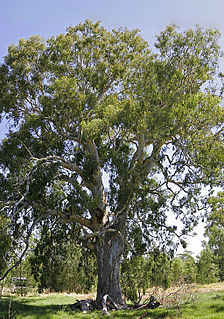Country
Marditjali ranged over a traditional land encompassing around 2,000 square miles (5,200 km2) from. Naracoorte in South Australia to the Victorian Wimmera area of Goroke and west of Mount Arapiles; They ranged as far south as Struan, Apsley, and Edenhope. Their northern boundaries were around Bangham, Kaniva, and Servicetown.

Naracoorte is a town in the Limestone Coast region of South Australia, approximately 336 kilometres south-east of Adelaide and 100 kilometres north of Mount Gambier on the Riddoch Highway (A66).

The Wimmera is a region of the Australian state of Victoria. The district is located within parts of the Loddon Mallee and the Grampians regions; and covers the dryland farming area south of the range of Mallee scrub, east of the South Australia border and north of the Great Dividing Range. It can also be defined as the land within the social catchment of Horsham, its main settlement.

Goroke is a town in the Wimmera region of Victoria. The town is located in the Shire of West Wimmera local government area, 370 kilometres (230 mi) north west of the state capital, Melbourne. At the 2016 census, Goroke recorded a population of 299.
Marditjali tribal areas were characterized by swampy zones encircled by imposing country was characterized by large red gum forests The frontier with the Bungandidj (Buandik) around Eden hope was marked by a brusque change in tree type, as red gums yielded to scrub gums. Their western boundaries with the Meintangk on the Naracoorte Range are likewise ecologically defined by the rising terraces of wooded lime sand dunes.

Eucalyptus camaldulensis, commonly known as the river red gum, is a tree that is endemic to Australia. It has smooth white or cream-coloured bark, lance-shaped or curved adult leaves, flower buds in groups of seven or nine, white flowers and hemispherical fruit with the valves extending beyond the rim. A familiar and iconic tree, it is seen along many watercourses across inland Australia, providing shade in the extreme temperatures of central Australia.
The Bungandidj people are Indigenous Australians from the Mount Gambier region in south-eastern South Australia, and also in western Victoria. Bungandidj was historically frequently rendered as "Boandik".

Eucalyptus cosmophylla is a tree of the genus eucalyptus that is native to South Australia, commonly occurring in the southern Mount Lofty Ranges and Kangaroo Island.
This page is based on this
Wikipedia article Text is available under the
CC BY-SA 4.0 license; additional terms may apply.
Images, videos and audio are available under their respective licenses.
The Kaurna people are a group of Indigenous Australians whose traditional lands include the Adelaide Plains of South Australia. Pronunciation of the word "Kaurna" varies slightly by the background and origin of the speaker; the most common is English, sometimes, native [ɡ̊auɲa] or, less often,. Kaurna culture and language were almost completely destroyed within a few decades of the European settlement of South Australia in 1836. However, extensive documentation by early missionaries and other researchers has enabled a modern revival of both language and culture.

The Ngadjuri people are a group of Indigenous Australian people whose traditional lands lie in the mid north of South Australia with a territory extending from Gawler in the south to Orroroo in the north.

The Barngarla, formerly known as Parnkalla, are an Aboriginal people of the Port Lincoln, Whyalla and Port Augusta areas. The Barngarla are the traditional owners of much of Eyre Peninsula, South Australia, Australia.
The Ngaiawang were an indigenous Australian people of South Australia. They are now considered extinct.
The Ngurunta or Runda are believed to have been an indigenous Australian people of the state of South Australia located immediately west of Lake Frome.
The Bodaruwitj (Potaruwutj) were an indigenous Australian people of the state of South Australia, now believed to be extinct. They may be the same as the Bindjali.
The Wanman are an indigenous Australian people of Western Australia's Pilbara region.
The Ngarinjin or Ngarinyin, also known as the Ungarinyin, are an indigenous Australian people of northern Western Australia.
The Yingkarta or Inggarda are an indigenous Australian people of Western Australia.
The Ngurlu, also known as the Ngulutjara, are an indigenous Australian people of Western Australia.
The Yeidji, otherwise commonly known as the Gwini, are an indigenous Australian people of the Kimberley area of Western Australia.
The Wilawila are an indigenous Australian tribe of the Kimberley region of Western Australia.
The Wurla, also written Ola, or Waladjangarri, are an indigenous Australian people of the Kimberley region of Western Australia
The Doolboong, also known as Duulngari, were an indigenous Australian people of the Northern Territory and northeast Western Australia.
The Ngaatjatjarra are an Indigenous Australian people of Western Australia.
The Kalaako (Kalarko) were an indigenous Australian people of the Goldfields-Esperance region of Western Australia.
The Antakirinja, otherwise spelt Antakarinya, and alternatively spoken of as the Ngonde, are an indigenous Australian people of South Australia.
The Yilba, also written Ilba, were an indigenous Australian people of the state of Queensland.
The Nauo (Nawu) were an indigenous Australian people of South Australia who spoke the Nauo language. They became extinct by the end of the nineteenth century.
The Jeithi were an indigenous Australian people of the state of New South Wales.








